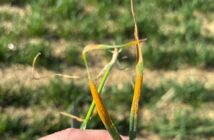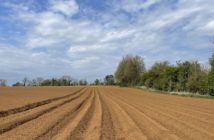Sclerotinia sprays will be the key focus for oilseed rape crops over the next three to four weeks. The risk has been low up until now, with soils too cold to trigger apothecia into significant spore release. But, with temperatures climbing and settled conditions, infection pressure is now escalating rapidly.
Furthermore, most crops have yet to start significant petal fall that is a key to infection outbreaks. Where petals coated with Sclerotinia ascospores stick on stems, they provide a food source that allows the disease to develop and penetrate into the plant. And that could be further exacerbated by the huge incidence of Cabbage Stem Flea Beetle larvae damage to leaf petioles that create an open entry point for infection.
Syngenta Field Technical Manager, James Southgate, urged growers to make Amistar applications now, if they have not yet already applied a Sclerotinia treatment. “There is still ample soil moisture and damp conditions within the crop canopy to allow infection to develop. All Sclerotinia fungicides work most effectively when applied prior to infection,” he advised.
“The key advantage with Amistar is that, even if infection doesn’t occur, crops still get the benefit of the greening effect and healthy leaf retention that drives economic yield and valuable improved oil content of seed.”
With significant Light Leaf Spot infection on lower leaves and the effects of CSFB infestation many plants already have damaged or decaying vegetative material at the bottom of the crop canopy – which could create ideal conditions for Sclerotinia infection.
James advocated applications should be targeted to coat petals with spray, but also with sufficient water volume and using angled nozzles to achieve penetration of the canopy and provide a protective coating throughout the plants.
Light Leaf Spot update
With this season’s cool weather conditions, until now, Light Leaf Spot has continued to develop in many oilseed rape crops, and even spread onto new leaves at the top of the canopy.
Walking crops in the Cotswolds last week (5th May), ADAS OSR pathologist, Faye Ritchie, identified pronounced twisting of new leaves that characterises early onset of Light Leaf Spot, with some early leaf spotting symptoms on the underside of leaves.
“The hot sunny weather should help to limit further development, but where disease is evident on upper leaves, growers and agronomists can consider including a LLS spray in the mix at this stage she advised.
James Southgate advocated that, where Light Leaf Spot is still active when the flowering spray is made, a good solution would be to tank mix Amistar at 0.5 – 0.8 l/ha with prothiaconazole to boost LLS activity.



